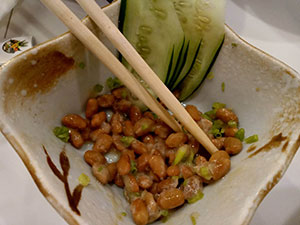
As an English teacher to Japanese students, being exposed to their cultures and traditions is something very usual to me. One of the things I like about Japanese customs is how they prepare their food. I like Japanese food either cooked or raw. However, there are some students of mine that caught my curiosity about specific Japanese food. They asked me, “Do you know natto?” “Have you tried natto?”. I asked them to describe its taste but no one succeeded in doing it. That leaves me no choice but to go to the nearest Japanese restaurant and try it myself.
What is Natto?
Natto is a unique Japanese delicacy with health benefits. It is a traditional Japanese food made from fermented soybeans, and has a distinct reputation for its sticky texture, pungent aroma, and acquired taste. It is often eaten with rice and various condiments. While it may not be everyone’s favorite, natto offers a variety of nutritional benefits.
The Origins and Preparation of Natto
The exact origins of natto are unclear, but it is believed to have been consumed in Japan for over a thousand years. Natto has been a staple of Japanese cuisine for centuries. The preparation involves steaming soybeans and fermenting them with Bacillus subtilis var. natto, a specific strain of bacteria. This fermentation process results in the formation of a sticky coating and gives natto its signature taste, smell, and texture.
Why Should You Try It?
While natto might not be everyone’s cup of tea due to its strong taste and sticky texture, it is worth a try for those who enjoy exploring diverse culinary traditions and are open to new flavors and experiences. Exploring new foods like natto expands one’s palate, fostering personal growth and an adventurous spirit in the realm of culinary exploration.
Here is a list of reason why non-Japanese individuals should consider trying natto:
The Unique Texture and Flavor Profile
One of the distinguishing features of natto is its slimy and sticky texture, which can be attributed to the breakdown of soybean proteins by the natto bacteria. While some people find this texture off-putting, others appreciate the unique mouthfeel. The flavor of natto is often described as nutty, savory, and slightly earthy, with a pungent aroma that can be an acquired taste.
Nutritional Benefits of Natto
Natto is a nutrient-dense food that offers several health benefits. It is an excellent source of protein, fiber, and vitamins, including vitamin K2, which is crucial for bone health and blood clotting. Additionally, natto contains beneficial bacteria and enzymes resulting from the fermentation process, which can support gut health and digestion.
Studies suggest that natto has various health benefits. Nattokinase, an enzyme produced during fermentation, has blood-thinning properties and may promote cardiovascular health. Some research indicates that natto consumption could positively impact cholesterol levels, blood pressure, and circulation. However, further studies are needed to fully understand these potential benefits.
How to Enjoy Natto?
For those willing to give natto a try, there are various ways to enjoy it. It is commonly eaten with a bowl of steamed rice, accompanied by condiments like soy sauce and mustard to balance the flavor. Natto can also be incorporated into sushi rolls or used as an ingredient in soups and stir-fries. Experimenting with different combinations and toppings, such as green onions or nori, can enhance the overall experience.
Embracing Cultural Exploration
Sampling natto provides an opportunity to explore Japanese culinary traditions and embrace cultural diversity through food. Trying new flavors and textures opens doors to unique sensory experiences and expands one’s culinary horizons. Even if natto doesn’t become a personal favorite, the exploration itself can be an enriching adventure.
Did I Like Natto?

As for my experience with natto, I found it to be an incredibly unusual food. When it comes to Japanese cuisine, I’m accustomed to dishes like sushi, ramen, and tempura, so natto stands out in comparison. Its appearance alone sets it apart from the typical Japanese foods I usually order and eat. The slimy texture and sticky strands that form when you mix it can be quite surprising and take some getting used to.
In terms of taste, I didn’t find it bad, but it didn’t become something that I would crave or seek out regularly either. The flavor of natto is unique, with a nutty and savory profile that is unlike anything I had tried before. I ate natto as is instead of eating with steamed rice some condiments. I wanted to know first how it taste if you eat it plain. It has a bitter after taste. The pungent aroma, which is often described as strong or even ammonia-like, adds to the overall distinctiveness of the experience. While I can appreciate the cultural significance and potential health benefits of natto, it didn’t become a personal favorite of mine.
However, it’s important to remember that taste preferences are subjective, and what one person enjoys, another might not. Despite my initial observations, I believe it’s worth giving natto a try to form your own opinion. It’s an opportunity to broaden your culinary horizons, experience new flavors and textures, and gain a deeper understanding of Japanese cuisine and culture. Who knows, you might even discover a newfound appreciation for this unconventional delicacy.
Conclusion
Natto, with its distinctive characteristics and potential health benefits, offers a glimpse into Japanese cuisine and culture. While the slimy texture and pungent aroma may not appeal to everyone, the nutritional profile and cultural experience make natto worth trying for those interested in expanding their palate and embracing new culinary adventures.
Trying new foods is an adventure in itself. It can be an opportunity to step out of one’s comfort zone and develop a more open-minded approach to different flavors, textures, and culinary traditions. By embracing diverse foods like natto, anyone can broaden their palate and appreciate the rich tapestry of global cuisine. So go ahead and give it a try!

Leave a Reply